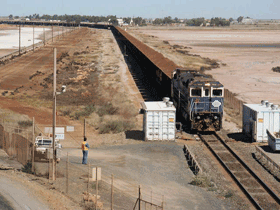|
![]()
![]()
Iron ore plant

![]()
Iron ore stockpile
|
Port Hedland is a remote coastal town of 15,000 people located in the Pilbara region of Western Australia. The oldest port in the Pilbara, Hedland today serves the iron ore mines of Mt. Goldsworthy, Shay Gap and Mt. Newman, Port Hedland being the largest iron ore port in the world. It is also the highest tonnage port in Australia with over 100 million tonnes being exported each year.
Built on an island 13 km long and 1.6 km wide, Port Hedland is connected to the mainland by four long causeways over tidal creeks. Located 1,670 kilometres from Perth, its name honours Captain Peter Hedland, of the cutter Mystery, which visited the area in 1863 on an exploratory voyage headed by Messrs Ridley and Parbury.
Originally known as Mangrove Harbour, it is at this location that Dutch navigator Gerritt de Witt was blown ashore in 1628 aboard the Vyanen but 260 years would pass before Port Hedland developed as a port after the discovery of gold at Marble Bar and Nullagine in 1888. The original port, named Condon, was near the mouth of the de Grey River. It is now an abandoned ruin.
Towards the end of the century it became apparent that the pastoral industry in the Eastern Pilbara needed a port, and in 1896 the first Port Hedland jetty was begun. With the discovery of gold in the Marble Bar area a few years later, the jetty was extended in 1908, and a railway between Marble Bar and Port Hedland was completed in 1911. From then until the late 1930s, the port was mainly used for the import of stores and producer items for the local industries, and the export of pearl shell, wool, livestock, gold, tin and small amounts of copper.
After World War II, the port continued to serve the pastoral industry, and began to export significant quantities of manganese. In 1965, Goldsworthy Mining (now BHP Billiton) dredged an approach channel and turning basin for ships of up to 65,000 dead weight tonnes, thus beginning the use of the port as an export point for iron ore mined in the Pilbara region. The Nelson Point iron ore crushing and shipping area, which dominates the landscape, receives high grade iron ore from Mount Whaleback after a 426 km journey over the longest privately operated railway in Australia. The two plants have a combined capacity of over 40 million tonnes a year. Crushed ore is stockpiled before being reclaimed and conveyed to the ore pier where two shiploaders feed the material into ore carriers of up to 200,000 tonnes dead weight destined for the steel mills of Australia and world markets including Japan, China, South Korea, Taiwan and Europe.
The satellite town of South Hedland (18 km inland) was established due to a shortage of land above cyclonic storm surge levels adjacent to the original town site. It used to possess the state's largest shopping complex outside the Perth metropolitan area. South Hedland is a modern centre with the ability to hold a population of 40 000. At the moment it houses the majority of the area's inhabitants.
Port Hedland has the unexplainable ability to draw people back time after time. The lack of acceptable infrastructure frequently leads people to leave but most are drawn back to the relaxing lifestyle. The current resources boom is addressing most of the issues with some exciting projects in the pipeline.
The area's harsh climate (hot and cyclonic in summer) and the fact that the town is permanently covered by layers of red dust from the Nelson Point iron ore crushing works, do little to encourage tourism, however the town's location on the ocean provides a variety of aquatic leisure activities including superb fishing for those who do visit the town. Nesting flatback turtles are seen in season, as are whales & dolphins. Sections of the coast are lined by a coral reef which at low tide leaves rock pools housing a vast array of corals, sea anemones, octopus, sea cucumbers & other amazing sea life. Millstream and Karijini National Parks are within easy driving distance, while Broome and the Kimberley are also within reach.
The original inhabitants, the Karriyarra people, call the place Marapikurrinya for the hand shaped formation of the tidal creeks coming off the natural harbour.
View Larger Map
|